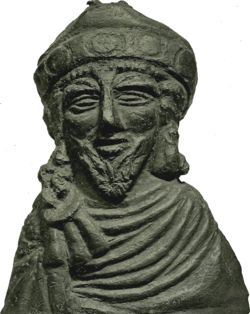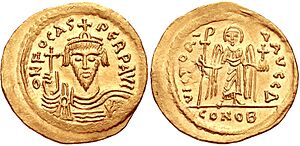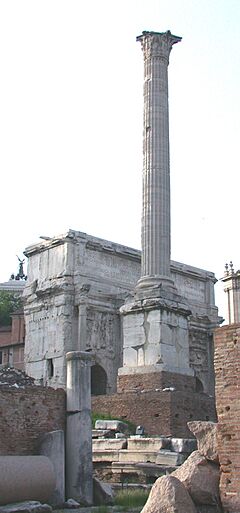Phocas facts for kids
Quick facts for kids Phocas |
|||||
|---|---|---|---|---|---|

A 7th-century bronze weight, possibly showing Emperor Phocas
|
|||||
| Byzantine emperor | |||||
| Reign | 23 November 602 – 5 October 610 | ||||
| Predecessor | Maurice and Theodosius | ||||
| Successor | Heraclius | ||||
| Born | 547 Thracia or Cappadocia |
||||
| Died | 5 October 610 (aged 62–63) Constantinople |
||||
| Spouse | Leontia | ||||
| Issue | Domentzia | ||||
|
|||||
| Mother | Domentzia | ||||
| Religion | Chalcedonian Christianity | ||||
Phocas (born 547, died 5 October 610) was a Byzantine emperor who ruled from 602 to 610. He started as a mid-level officer in the Eastern Roman army. Phocas became important when he spoke for soldiers who were unhappy with Emperor Maurice.
In 602, the army rebelled. Phocas became their leader. The revolt worked, and they took control of Constantinople. Emperor Maurice was overthrown on November 23, 602. Phocas then declared himself emperor on the same day.
Phocas did not trust the powerful people in Constantinople. He thought they saw him as an outsider. So, he put his family members in important military and government jobs. He faced big problems both inside and outside the empire. He dealt with people who opposed him very harshly. This made more and more people dislike him. At the same time, the empire was attacked from many sides. The Avars and Slavs raided the Balkans. The Sasanian Empire started a huge war in the eastern parts of the empire.
Finally, Heraclius the Elder, a powerful governor in Africa, rebelled against Phocas. Many people across the empire supported him. Phocas tried to use soldiers from the borders to stop the rebellion. But this just allowed invaders to push deeper into the empire. Heraclius the Elder's son, Heraclius, captured Constantinople on October 5, 610. Phocas was killed that same day, and Heraclius became the new emperor.
Writers from that time were very negative about Phocas. They described him as a bad ruler who was not good at his job. They said he was cruel to anyone he thought was against him. They also blamed him for leaving the empire open to attacks. It's hard to know if these stories are completely true. The emperors who came after Phocas wanted to make him look bad. This made their own rule seem more rightful.
Contents
Life of Phocas
Early Years
Phocas was likely born in 547. He was said to be 55 years old when he became emperor. His family probably came from Thraco-Roman or Cappadocian areas. We don't know much about Phocas's life before he became emperor. We do know he was a low-ranking officer under Emperor Maurice.
How He Became Emperor
In 602, the Byzantine army rebelled against Emperor Maurice. The soldiers were tired and angry. They were upset about having to fight north of the Danube River in winter. They were also mad about earlier pay cuts. The army chose Phocas, who was a centurion (a military officer), as their new emperor. They lifted him onto a shield, which was a traditional way to declare an emperor.
On November 23, 602, Phocas was crowned by the patriarch Cyriacus. This happened in the church of St John the Baptist at Hebdomon. Two days later, on November 25, he entered Constantinople. Maurice tried to escape with his sons, Theodosius and Tiberius. But they were soon caught and killed. Maurice's wife and daughters were sent to a monastery and later also killed.
Wars and Conflicts
Even after killing the previous emperor, Phocas felt unsafe. He spent a lot of time trying to find and stop enemies and plots against him. Because of this, and the local resistance he faced, he couldn't deal with attacks on the empire's borders. The Avars and Slavs launched many raids into the Balkan parts of the Byzantine Empire. The Sassanian Empire also started a war in the eastern provinces.
The Avars took all the land in the Balkans north of Thessalonica. People in Christian cities were killed or captured. The Byzantines moved most of their soldiers to the eastern border. This was because the Persians were a big threat.
The Sassanid Persians had been at peace with Maurice. They had made a treaty with him in 591. After Phocas took power and killed Maurice, the Persians invaded the empire in 603. The Sassanids quickly took over the eastern provinces. Their army leader, Narses, even joined the Persians. Phocas quickly dealt with Narses. He invited him to Constantinople, promising him safety. But when Narses arrived, Phocas had him burned alive. By 607, the Sassanids had taken Mesopotamia, Syria, and much of Asia Minor. They reached as far as the Bosphorus.
By the end of Phocas's rule in 610, the Persians had crossed the Euphrates River. They had also taken the city of Zenobia. Stories from that time say the Persians were very cruel to the people they conquered.
How Phocas Ruled
Phocas found it hard to control the government or the army. He didn't trust most of the powerful people in Constantinople. He had no connection to them before becoming emperor. So, he often gave important military jobs to his relatives. For example, he made his brother Domentziolus a top official in 603. He made his nephew Domentziolus the military commander for the eastern provinces in 604. Around 610, he made his other brother Comentiolus a military commander too. All three stayed loyal to Phocas until Heraclius killed them.
Phocas also appointed Priscus as the captain of the Excubitors (a special guard unit) in 603. Priscus was Phocas's son-in-law, married to his daughter Domentzia.
Policy in Italy
When Phocas was emperor, Byzantine Italy was constantly attacked by the Lombards. But the Byzantine government sent few resources to help Italy. This was because they had problems elsewhere. During Phocas's entire rule, the only public building project in Rome paid for by taxes was a statue of Phocas. It was finished in 608.
When Phocas took power, Gregory the Great was the bishop of Rome. He praised Phocas as someone who brought back freedom. Gregory called him a kind and religious leader. He even compared Phocas's wife, Empress Leontia, to Pulcheria, a respected empress from the past. In May 603, pictures of the emperor and empress arrived in Rome. The pope ordered them to be placed in a special chapel in the imperial palace.
At that time, the emperor's approval was needed to choose a new pope. When Pope Sabinian died in 606, approval was delayed for a year. Phocas was busy dealing with enemies who threatened his rule. He finally gave his approval in 607, and Boniface III became pope. Phocas declared Rome to be "the head of all churches." Soon after, Phocas had a golden statue of himself put on a large column in the Roman Forum. This is known as the Column of Phocas.
His Downfall
Even though Priscus was made a top guard captain, he was not loyal to Phocas. In 608, he asked Heraclius the Elder, the governor of Carthage, to rebel against Phocas. Heraclius the Elder agreed. He started preparing to invade. He cut off the supply of grain to Constantinople. He also gathered a large army and navy.
Heraclius the Elder launched his invasion in 609. His nephew, Nicetas, marched troops over land to the capital. His son, Heraclius, led a naval invasion to Thessalonica. Then, he marched to Constantinople. Heraclius arrived outside Constantinople on October 3, 610. He took control of the city on October 5. Heraclius was declared emperor on the same day. Phocas was quickly put to death.
What We Remember About Phocas
Phocas is usually shown as a bad guy by historians, both from his time and today. But some of the earliest stories about Phocas were written during the rule of Heraclius. These writings might not be completely fair. The writers would have wanted to make Phocas look bad to make Heraclius's rule seem stronger.
In terms of fashion, Phocas brought back wearing a beard for emperors. Before him, emperors since Constantine the Great (who ruled from 306 to 337) had been clean-shaven. This new beard fashion lasted until the end of the Byzantine Empire.
On February 19, 607, Emperor Phocas appointed Boniface III as the new bishop of Rome. Phocas then issued an official order from the Roman government. This order recognized Boniface III as the "Head of all Churches" and "Universal Bishop." Phocas moved this title from the Diocese of Constantinople to the Diocese of Rome. Boniface wanted and got this order from Phocas. It stated that "the See of Blessed Peter the Apostle should be the head of all the Churches." It also made sure the title of "Universal Bishop" belonged only to the Bishop of Rome. This action stopped Patriarch Cyriacus of Constantinople from trying to call himself "Universal Bishop."
By calling the Pope the "head of all churches," Phocas's order became important in discussions about the Pope's special role and power.
|
See also
 In Spanish: Focas (emperador) para niños
In Spanish: Focas (emperador) para niños





